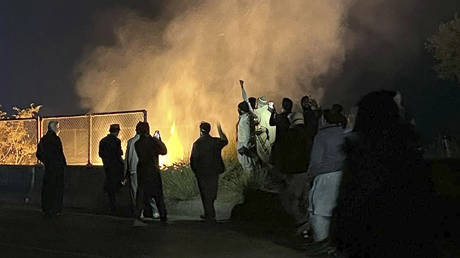Kodak is having a fashion moment.
A few weeks ago, a keychain-sized camera-slash-accessory based on a model from 1987 sold out in a day. In some markets, the company’s compact digital cameras have outsold those from Canon or Sony. Things are going so well, Kodak has even developed a popular streetwear brand with a storefront in Seoul, luring young people with bright colors and a fun, retro vibe. Not bad for a 133-year-old company that declared bankruptcy in 2012 and in August refuted reports that it may have to shut down again.
Inventor and entrepreneur George Eastman founded the Eastman Kodak Company in Rochester, New York, in 1888. Over the next century, the word Kodak — which George Eastman made up — essentially became synonymous with the act of taking pictures. It democratized photography with the affordable Brownie camera in 1900, then revolutionized it again in 1935 with Kodachrome, one of the first commercially successful color films. In 1975, a Kodak engineer invented the first digital camera — and by the end of that decade, the company was making billions of dollars per year.
But throughout much of the 20th century, Kodak was also, for all intents and purposes, a U.S. military contractor. Alongside its subsidiary Eastman Chemical, Kodak produced warplane lacquer, gas mask parts, and refined uranium for the Manhattan Project.
All of this left a long trail of environmental damage, most notably in Rochester. In the 1940s and 1950s, Kodak disposed of low-level radioactive waste in a local landfill. By 1990, the company had been repeatedly cited for mishandling hazardous chemicals, including failing to report toxic spills, illegally discharging solvents into the city’s sewer system, and flouting air pollution regulations. People living near the factory began to notice clusters of rare diseases. In 1994, Kodak agreed to an $8 million settlement to repair leaking sewers that had carried industrial waste beneath the city for decades. According to an Environmental Working Group report released that year, during the first half of the 1990s, the company released more recognized carcinogens into the water than any other polluter in New York.
In her new book, Tales of Militant Chemistry, film historian Alice Lovejoy reveals this little-known aspect of the film industry, profiling both Kodak and its German contemporary, Agfa, a film company which at one point retooled a portion of its factory to produce poison gas for World War I. Agfa, too, polluted the towns in which its factories resided — even inspiring a documentary film, Bitterness in Bitterfeld, which, as Lovejoy recounts, was then shared clandestinely throughout East Germany’s underground environmental movement.
Although Kodak has since pledged to cut emissions and committed tens of millions of dollars to cleanup — and now posts regular Earth Day missives about corporate-sustainability goals — much of that polluting legacy remains. When asked about the history Lovejoy outlines in her book, Kodak sent a copy of its current sustainability report and declined to comment further.
“A company like Kodak, which we think of as this company that pioneered the snapshot that lives in this cultural realm, is deeply embedded in changing the substance of our world,” Lovejoy told Grist. That has had a profound impact on the environment and on frontline communities. But to most of the world, it’s still just the company that makes cameras. In her book, Lovejoy recounts the story of a Kodak representative telling people impacted by a methylene chloride spill, “We’ve never been thought of as a chemical company … we just made the yellow boxes.”
That, Lovejoy said, might be the company’s public image, but it was never the truth. “Internally, they identified themselves as a chemical company,” she said. And for Lovejoy, “the environment and the military can’t be separated.”
“The history of this material comes through poison gas, and it comes through the atomic bomb, and it comes through all of these materials that are really part of the history of the 20th and now 21st century.”
Household names like DuPont, General Electric, and Exxon are among those that have similarly left the land, the water, and the air in the communities around them polluted — often while also serving as contractors for entities such as the Department of Defense. All have kept their environmental and social harms (and military ties) largely out of public view until decades after the fact, when they’re sometimes forced to pay for remediation.
Since then, some of these companies have pivoted into the circular economy, Lovejoy explained. Among them is Eastman Chemical, the Tennessee-based Kodak subsidiary. Today, it works mostly in plastics, as Grist has reported, and has scooped up federal decarbonization grants despite knowing that plastics recycling only sort of works. In July, President Donald Trump gave Eastman Chemical a two-year exemption from an environmental regulation that would require it to report carcinogenic emissions. Kodak itself, meanwhile, still makes much of the world’s film in Rochester — but at a vastly smaller scale than it once did.
“Tales of Militant Chemistry” shows how the products a company is famous for might be only a tiny part of its social and environmental legacy. That lesson applies to products like smartphones and solar panels today, Lovejoy said. “Is film around anymore? Yeah, sort of, but it’s not what it used to be,” Lovejoy said. “But the environmental impacts are still with us, and they will be for a very, very long time.”
“This isn’t just a Kodak story,” Lovejoy said. It’s a story of how resource-intensive, even violent industries can often be obscured by great PR. Just as the uranium nitrite used as a toner for Kodak film depended on colonial mining in the Belgian Congo, batteries and solar panels are similarly dependent on extractive industries.
“I think we need to have a more realistic view of what companies like these are and do,” Lovejoy said. “For those of us who consume a lot of media, that means understanding the deeper global networks that underpin our devices or our experiences at the cinema or the shows that we’re watching while we’re streaming.”
This story was originally published by Grist with the headline Buoyed by a retro revival, Kodak’s dark environmental past is coming to light on Oct 9, 2025.





